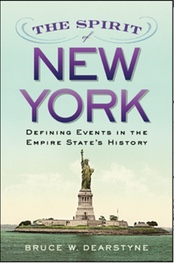Our Immigration Debate Is Stuck. Here’s How to Move It.

The public discussion these days of immigration issues – DACA, "Dreamers," President Trump's proposed border wall and restriction of immigration from predominantly Muslim countries – is contentious, divisive, and stuck in a rut. People have taken hardened positions, compromise is too often dismissed as surrender, and genuine dialog and fresh new perspectives are all too rare.
A similar situation was in place in the years leading up to American entry into World War I. Immigrants were entering in large numbers but many were from southern and eastern Europe, unlike previous waves of immigrants from northern and western Europe. More Jews were entering than in the past. There was public concern that these new immigrants would cling to the ways of their homelands or religious or ethnic groups and undermine American institutions.
 The
debate was stuck in a sense. A new set of perspectives and ways of
framing the issue were needed.
The
debate was stuck in a sense. A new set of perspectives and ways of
framing the issue were needed.
That came in a sense when the magazine The Nation published an essay entitled "Democracy Versus the Melting Pot: A Study of American Nationality," by University of Wisconsin philosophy professor Horace M. Kallen, in February 1915.
Kallen was primarily responding to a 1914 book by another University of Wisconsin professor, sociologist Edward A. Ross, The Old World in the New: The Significance of Past and Present Immigration to the American People. Ross's rendering of anti-immigrant, nativist views represented a distillation of the restrictionist, racist perspectives of the era.
Ross contended that early settlers – English, Germans, and Irish – and their descendants embodied and reflected American values, culture, and political beliefs. They had reached "such a degree of political like-mindedness that fundamentals are taken for granted." But newer immigrants – for instance, Italians, Polish, Slavs, and Eastern European Jews – were not part of this consensus. They had not passed "civic kindergarten ... the plain truth is that seldom does the immigrant bring in his intellectual baggage anything that is any use to us." The new wave of immigrants would debase wages, burden social institutions, and stick together rather than assimilate. Too often they tended to be lazy and inclined toward criminality. "Respect for our ancestors" and "pride of race" suggested the need for restrictions on immigration.
Ross's extreme views proved a perfect foil for Kallen's eloquent rebuttal and proposal for a new way of looking at the issues.
America never was and was not becoming a "nation of nations" said Kallen but instead a "culture of cultures." Immigrants from the beginning have not "stippled the country in small units of diverse ethnic groups" but have either integrated with, or learned to live in harmony with, each other.
"In these days of ready-made clothes, factory-made goods, [and] refrigerating plants, it is almost impossible that the mass of the inhabitants of this country should wear other than uniform clothes, use other than uniform furniture or utensils, or eat anything but the same kind of food," Kallen contended. "In these days of rapid transit and industrial mobility it must seem impossible that any stratification of population should be permanent."
Other natural forces helped foster integration. "This mobility reinforces the use of English – for a lingua franca, intelligible everywhere, becomes indispensable – by immigrants," Kallen explained. Public schools helped impart common values. Groups became part of the fabric of American life in various ways. He went on, “but each nationality expresses its emotional and voluntary life in its own language, in its own inevitable aesthetic and intellectual forms." Government should protect cultural diversity rather than imposing cultural or ethnic conformity.
Economic forces and capitalism's natural desire for profits, not immigrants, accounted for low wages in some industries, Kallen contended. Poverty was the result of multiple circumstances, not something caused by, or endemic to, new immigrants.
A new metaphor was needed, said Kallen. Rather than the "melting pot" or even "E Pluribus Unum," Kallen proposed the paradigm of an orchestra, "a multiplicity in a unity, an orchestration of mankind. As in an orchestra, every type of instrument has its specific timbre and tonality, founded in its substance and form; as every type has its appropriate theme and melody in the whole symphony, so in society each ethnic group is the natural instrument, its spirit and culture are its theme and melody, and the harmony and dissonances and discords of them all make the symphony of civilization."
The United States would continue and get stronger as a unified nation over time. Immigrants were not a threat to our political institutions. They supported democratic values and institutions, though each group might do so in a way that reflected its history and perspectives. But "the range and variety of the harmonies may become wider and richer and more beautiful."
Of course, others had written in a similar vein and Kallen had his limits. For instance, women, blacks, native peoples, and some other groups are not featured in his narrative. But Kallen stood out in at least three ways.
One, he was not argumentative. His narrative was calm, persuasive, soothing and reassuring.
Two, he drew on American history to support and illustrate his contentions, thereby connecting with public sentiments of national pride and patriotism. Kallen distilled the central theme nicely in the catchy term "cultural pluralism" in a 1924 book, Culture and Democracy in the United States.
Three, as Mike Wallace explains in his new book, Greater Gotham: A History of New York City From 1898 to 1919, Kallen got the attention of influential writers and publicists in New York's progressive/liberal community, including Columbia University philosophy professor John Dewey and reformer Randolph Bourne, who began writing in a same vein.
Of course, anti-immigrant sentiment continued and the insistence on "100% Americanism" intensified after the nation entered the war in 1917. But Kallen and other like-minded thinkers and writers leavened and enriched the conversation, demonstrating that immigrants were not a threat, and conveying confidence in our diversity. He demonstrated that American history is complicated, subject to revision and interpretation over time, and that simple analyses and explanations, particularly when packaged in polemical form with ultra-nationalist, racist tinges, are often misleading.
American values and institutions stand the test of time but are changed by succeeding generations and newcomers. Unrestricted immigration is inadvisable, but so also is trying to restrict by geography, race, and religion. We could use someone like Horace Kallen today as a catalyst to help foster new ways of looking at the issue and new ways of restarting and enhancing public debate.